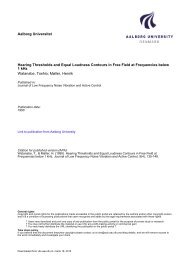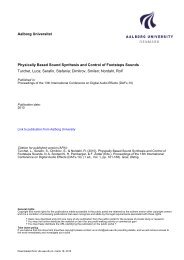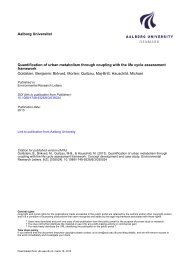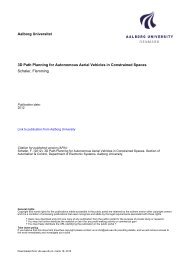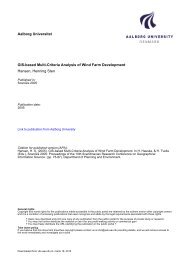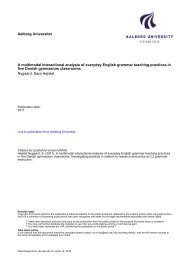Policy and planning for large-infrastructure projects ... - Bent Flyvbjerg
Policy and planning for large-infrastructure projects ... - Bent Flyvbjerg
Policy and planning for large-infrastructure projects ... - Bent Flyvbjerg
You also want an ePaper? Increase the reach of your titles
YUMPU automatically turns print PDFs into web optimized ePapers that Google loves.
Environment <strong>and</strong> Planning B: Planning <strong>and</strong> Design 2007, volume 34, pages 578 ^ 597<br />
DOI:10.1068/b32111<br />
<strong>Policy</strong> <strong>and</strong> <strong>planning</strong> <strong>for</strong> <strong>large</strong>-<strong>infrastructure</strong> <strong>projects</strong>: problems,<br />
causes, cures<br />
<strong>Bent</strong> <strong>Flyvbjerg</strong><br />
Aalborg University, Department of Development <strong>and</strong> Planning, Fibigerstraede 13, 9220 Aalborg,<br />
Denmark; e-mail: flyvbjerg@plan.aau.dk<br />
Received 20 June 2005; in revised <strong>for</strong>m 19 December 2005; published online 9 March 2007<br />
Abstract. This paper focuses on problems <strong>and</strong> their causes <strong>and</strong> cures in policy <strong>and</strong> <strong>planning</strong> <strong>for</strong><br />
<strong>large</strong>-<strong>infrastructure</strong> <strong>projects</strong>. First, it identifies as the main problem in major <strong>infrastructure</strong> developments<br />
pervasive misin<strong>for</strong>mation about the costs, benefits, <strong>and</strong> risks involved. A consequence<br />
of misin<strong>for</strong>mation is cost overruns, benefit shortfalls, <strong>and</strong> waste. Second, it explores the causes of<br />
misin<strong>for</strong>mation <strong>and</strong> finds that political-economic explanations best account <strong>for</strong> the available<br />
evidence: planners <strong>and</strong> promoters deliberately misrepresent costs, benefits, <strong>and</strong> risks in order to<br />
increase the likelihood that it is their <strong>projects</strong>, <strong>and</strong> not those of their competition, that gain<br />
approval <strong>and</strong> funding. This results in the `survival of the unfittest', in which often it is not the<br />
best <strong>projects</strong> that are built, but the most misrepresented ones. Finally, it presents measures <strong>for</strong><br />
re<strong>for</strong>ming policy <strong>and</strong> <strong>planning</strong> <strong>for</strong> <strong>large</strong>-<strong>infrastructure</strong> <strong>projects</strong> with a focus on better <strong>planning</strong><br />
methods <strong>and</strong> changed governance structures, the latter being more important.<br />
Introduction<br />
For a number of years the research group on <strong>large</strong> <strong>infrastructure</strong> at Aalborg University,<br />
Denmark, has explored different aspects of the <strong>planning</strong> of <strong>large</strong>-<strong>infrastructure</strong><br />
<strong>projects</strong> (<strong>Flyvbjerg</strong>, 2005a; 2005b; Flyvberg <strong>and</strong> COWI, 2004; <strong>Flyvbjerg</strong> et al, 2002;<br />
2003; 2004; 2005). (1) In this paper I take stock of what may be learned from the<br />
research so far.<br />
First, I will argue that a major problem in the <strong>planning</strong> of <strong>large</strong>-<strong>infrastructure</strong><br />
<strong>projects</strong> is the high level of misin<strong>for</strong>mation about costs <strong>and</strong> benefits that decisionmakers<br />
face in deciding whether to build, <strong>and</strong> the high risks such misin<strong>for</strong>mation<br />
generates. Second, I will explore the causes of misin<strong>for</strong>mation <strong>and</strong> risk, mainly in the<br />
guise of optimism bias <strong>and</strong> strategic misrepresentation. Finally, I will present a number<br />
of measures aimed at improved <strong>planning</strong> <strong>and</strong> decisionmaking, including changed<br />
incentive structures <strong>and</strong> better <strong>planning</strong> methods. Thus the paper is organized as a<br />
simple triptych consisting of problems, causes, <strong>and</strong> cures.<br />
The emphasis will be on transportation <strong>infrastructure</strong> <strong>projects</strong>. I would like<br />
to mention at the outset, however, that comparative research shows that the<br />
problems, causes, <strong>and</strong> cures we identify <strong>for</strong> transportation apply to a wide range<br />
of other project types including power plants, dams, water <strong>projects</strong>, concert halls,<br />
museums, sports arenas, convention centers, in<strong>for</strong>mation technology systems,<br />
oil <strong>and</strong> gas extraction <strong>projects</strong>, aerospace <strong>projects</strong>, <strong>and</strong> weapons systems (Altshuler<br />
<strong>and</strong> Luberoff, 2003; <strong>Flyvbjerg</strong>, 2005a; <strong>Flyvbjerg</strong> et al, 2002, page 286; 2003,<br />
pages 18^19).<br />
(1)<br />
By `<strong>large</strong>-<strong>infrastructure</strong> <strong>projects</strong>' I here mean the most-expensive <strong>infrastructure</strong> <strong>projects</strong> that are<br />
built in the world today, typically at costs per project from around a hundred million to several<br />
billion dollars.
<strong>Policy</strong> <strong>and</strong> <strong>planning</strong> <strong>for</strong> <strong>large</strong>-<strong>infrastructure</strong> <strong>projects</strong> 579<br />
Problems<br />
Large-<strong>infrastructure</strong> <strong>projects</strong>, <strong>and</strong> <strong>planning</strong> <strong>for</strong> such <strong>projects</strong>, generally have the<br />
following characteristics (<strong>Flyvbjerg</strong> <strong>and</strong> COWI, 2004):<br />
(1) Such <strong>projects</strong> are inherently risky because of long <strong>planning</strong> horizons <strong>and</strong> complex<br />
interfaces.<br />
(2) Technology is often not st<strong>and</strong>ard.<br />
(3) Decisionmaking <strong>and</strong> <strong>planning</strong> are often multiactor processes with conflicting<br />
interests.<br />
(4) Often the project scope or ambition level will change significantly over time.<br />
(5) Statistical evidence shows that such unplanned events are often unaccounted <strong>for</strong>,<br />
leaving budget contingencies sorely inadequate.<br />
(6) As a consequence, misin<strong>for</strong>mation about costs, benefits, <strong>and</strong> risks is the norm.<br />
(7) The results are cost overruns <strong>and</strong>/or benefit shortfalls <strong>for</strong> the majority of <strong>projects</strong>.<br />
The size of cost overruns <strong>and</strong> benefit shortfalls<br />
For transportation <strong>infrastructure</strong> <strong>projects</strong>, table 1 shows the inaccuracy of constructioncost<br />
estimates measured as the size of cost overrun. The cost study covers 258 <strong>projects</strong><br />
in twenty nations on five continents. All <strong>projects</strong> <strong>for</strong> which data were obtainable were<br />
included in the study. (2) For rail, average cost overrun is 44.7% measured in constant<br />
prices. For bridges <strong>and</strong> tunnels, the equivalent figure is 33.8%, <strong>and</strong> <strong>for</strong> roads 20.4%.<br />
The difference in cost overrun between the three project types is statistically significant,<br />
indicating that each type should be treated separately (<strong>Flyvbjerg</strong> et al, 2002).<br />
Table 1. Inaccuracy of transportation-project cost estimates by type of project, in constant prices.<br />
Type of project Number of Average cost St<strong>and</strong>ard deviation<br />
cases (N ) overrun (%)<br />
Rail 58 44.7 38.4<br />
Bridges <strong>and</strong> tunnels 33 33.8 62.4<br />
Road 167 20.4 29.9<br />
The <strong>large</strong> st<strong>and</strong>ard deviations shown in table 1 are as interesting as the <strong>large</strong> average<br />
cost overruns. The size of the st<strong>and</strong>ard deviations demonstrates that uncertainty <strong>and</strong><br />
risk regarding cost overruns are <strong>large</strong>, indeed.<br />
The following key observations pertain to cost overruns in transportation<br />
<strong>infrastructure</strong> <strong>projects</strong>:<br />
(1) Nine out of ten <strong>projects</strong> have cost overrun.<br />
(2) Overrun is found across the twenty nations <strong>and</strong> five continents covered by the<br />
study.<br />
(3) Overrun is constant <strong>for</strong> the seventy-year period covered by the studyöestimates<br />
have not improved over time.<br />
(2)<br />
The data are from the <strong>large</strong>st database of its kind. All costs are construction costs measured in<br />
constant prices. Cost overrun, also sometimes called `cost increase' or `cost escalation', is measured<br />
according to international convention as actual out-turn costs minus estimated costs as a percentage<br />
of estimated costs. Actual costs are defined as real, accounted construction costs determined at<br />
the time of project completion. Estimated costs are defined as budgeted, or <strong>for</strong>ecasted, construction<br />
costs at the time of decision to build. For reasons explained in <strong>Flyvbjerg</strong> et al (2002) the<br />
figures <strong>for</strong> cost overrun presented here must be considered conservative. Ideally financing costs,<br />
operating costs, <strong>and</strong> maintenance costs would also be included in a study of costs. It is difficult,<br />
however, to find valid, reliable, <strong>and</strong> comparable data on these types of costs across <strong>large</strong> numbers<br />
of <strong>projects</strong>. For details on methodology, see <strong>Flyvbjerg</strong> et al (2002).
580 B <strong>Flyvbjerg</strong><br />
Table 2 shows the inaccuracy of travel-dem<strong>and</strong> <strong>for</strong>ecasts <strong>for</strong> rail <strong>and</strong> road <strong>projects</strong>.<br />
The dem<strong>and</strong> study covers 208 <strong>projects</strong> in fourteen nations on five continents. All<br />
<strong>projects</strong> <strong>for</strong> which data were obtainable were included in the study. (3) For rail, actual<br />
passenger traffic is 51.4% lower than estimated traffic on average. This is equivalent<br />
to an average overestimate in rail-passenger <strong>for</strong>ecasts of no less than 105.6%. The result<br />
is <strong>large</strong> benefit shortfalls <strong>for</strong> rail. For roads, actual vehicle traffic is on average 9.5%<br />
higher than <strong>for</strong>ecast traffic. We see that rail-passenger <strong>for</strong>ecasts are biased, whereas<br />
this is not the case <strong>for</strong> road-traffic <strong>for</strong>ecasts. The difference between rail <strong>and</strong> road is<br />
statistically significant at a high level. Again the st<strong>and</strong>ard deviations are <strong>large</strong>, indicating<br />
that <strong>for</strong>ecasting errors vary widely across <strong>projects</strong> (<strong>Flyvbjerg</strong>, 2005b; <strong>Flyvbjerg</strong><br />
et al, 2005).<br />
Table 2. Inaccuracy in <strong>for</strong>ecasts of rail passenger <strong>and</strong> road-vehicle traffic.<br />
Type of project Number of Average St<strong>and</strong>ard deviation<br />
cases (N ) inaccuracy (%)<br />
Rail 25 51.4 28.1<br />
Road 183 9.5 44.3<br />
The following observations hold <strong>for</strong> traffic-dem<strong>and</strong> <strong>for</strong>ecasts:<br />
(1) 84% of rail passenger <strong>for</strong>ecasts are wrong by more than 20%.<br />
(2) Nine out of ten rail <strong>projects</strong> have overestimated traffic.<br />
(3) 50% of road-traffic <strong>for</strong>ecasts are wrong by more than 20%.<br />
(4) The number of roads with overestimated <strong>and</strong> underestimated traffic, respectively,<br />
is about the same.<br />
(5) Inaccuracy in traffic <strong>for</strong>ecasts is found in the fourteen nations <strong>and</strong> five continents<br />
covered by the study.<br />
(6) Inaccuracy is constant <strong>for</strong> the thirty-year period covered by the studyö<strong>for</strong>ecasts<br />
have not improved over time.<br />
We conclude that, if techniques <strong>and</strong> skills <strong>for</strong> arriving at accurate cost <strong>and</strong> traffic<br />
<strong>for</strong>ecasts have improved over time, these improvements have not resulted in an increase<br />
in the accuracy of <strong>for</strong>ecasts.<br />
If we combine the data in tables 1 <strong>and</strong> 2, we see that <strong>for</strong> rail an average cost<br />
overrun of 44.7% combines with an average traffic shortfall of 51.4%. (4) For roads,<br />
an average cost overrun of 20.4% combines with a fifty-fifty chance that traffic is also<br />
wrong by more than 20%. As a consequence, cost ^ benefit analyses <strong>and</strong> social-impact<br />
<strong>and</strong> environmental-impact assessments based on cost <strong>and</strong> traffic <strong>for</strong>ecasts like those<br />
described above will typically be highly misleading.<br />
Examples of cost overruns <strong>and</strong> benefit shortfalls<br />
The list of examples of <strong>projects</strong> with cost overruns <strong>and</strong>/or benefit shortfalls is seemingly<br />
endless (Flyvberg, 2005a). Boston's Big Dig, otherwise known as the Central<br />
Artery/Tunnel Project, was 275% or US $11 billion over budget in constant dollars<br />
when it opened, <strong>and</strong> further overruns are accruing because of faulty construction.<br />
(3)<br />
Following international convention, inaccuracy is measured as actual traffic minus estimated<br />
traffic as a percentage of estimated traffic. Rail traffic is measured as number of passengers;<br />
road traffic as number of vehicles. The base year <strong>for</strong> estimated traffic is the year of decision to<br />
build. The <strong>for</strong>ecasting year is the first full year of operations. Two statistical outliers are not<br />
included here. For details on methodology, see <strong>Flyvbjerg</strong> (2005b).<br />
(4)<br />
For each of twelve urban rail <strong>projects</strong>, we have data <strong>for</strong> both cost overrun <strong>and</strong> traffic shortfall.<br />
For these <strong>projects</strong> average cost overrun is 40.3%; average traffic shortfall is 47.8%.
<strong>Policy</strong> <strong>and</strong> <strong>planning</strong> <strong>for</strong> <strong>large</strong>-<strong>infrastructure</strong> <strong>projects</strong> 581<br />
Actual costs <strong>for</strong> Denver's $5 billion International Airport were close to 200% higher<br />
than estimated costs. The overrun on the San Francisco ^ Oakl<strong>and</strong> Bay Bridge retrofit<br />
was $2.5 billion, or more than 100%, even be<strong>for</strong>e construction started. The Copenhagen<br />
metro <strong>and</strong> many other urban rail <strong>projects</strong> worldwide have had similar overruns. The<br />
Channel tunnel between the United Kingdom <strong>and</strong> France came in 80% over budget <strong>for</strong><br />
construction <strong>and</strong> 140% over <strong>for</strong> financing. At the initial public offering, Eurotunnel,<br />
the private owner of the tunnel, lured investors by telling them that 10% ``would be a<br />
reasonable allowance <strong>for</strong> the possible impact of un<strong>for</strong>eseen circumstances on construction<br />
costs'' (The Economist 1989). Outside of transportation, the $4 billion cost overrun<br />
<strong>for</strong> the Pentagon spy-satellite program <strong>and</strong> the over $5 billion overrun on the International<br />
Space Station are typical of defense <strong>and</strong> aerospace <strong>projects</strong>.Our studies show<br />
that <strong>large</strong> <strong>infrastructure</strong> <strong>and</strong> technology <strong>projects</strong> tend statistically to follow a pattern of<br />
cost underestimation <strong>and</strong> overrun. Many such <strong>projects</strong> end up financial disasters.<br />
Un<strong>for</strong>tunately, the consequences are not always only financial, as is illustrated by the<br />
NASA space shuttle. Here, the cooking of budgets to make this underper<strong>for</strong>ming<br />
project look good on paper has been linked with shortchanged safety upgrades related<br />
to the deaths of seven astronauts aboard the Columbia shuttle in 2003 (<strong>Flyvbjerg</strong>, 2004).<br />
As <strong>for</strong> benefit shortfalls, consider Bangkok's US $2 billion Skytrain, a two-track<br />
elevated urban rail system designed to service some of the most densely populated<br />
areas from the air. The system is greatly oversized, with station plat<strong>for</strong>ms too long <strong>for</strong><br />
its shortened trains; many trains <strong>and</strong> cars sit in the garage, because there is no need<br />
<strong>for</strong> them; terminals are too <strong>large</strong>; <strong>and</strong> so on. The reason is that actual traffic turned<br />
out to be less than half that <strong>for</strong>ecast (<strong>Flyvbjerg</strong> et al, 2005, page 132). Every ef<strong>for</strong>t has<br />
been made to market <strong>and</strong> promote the train, but the project company has ended up<br />
in financial trouble. Even though urban rail is probably a good idea <strong>for</strong> a dense,<br />
congested, <strong>and</strong> air-polluted city like Bangkok, overinvesting in idle capacity is hardly<br />
the best way to use resources, especially in a developing nation in which capital <strong>for</strong><br />
investment is particularly scarce. Such benefit shortfalls are common <strong>and</strong> have also<br />
haunted the Channel tunnel, the Los Angeles <strong>and</strong> Copenhagen metros, <strong>and</strong> Denver's<br />
International Airport.<br />
Other <strong>projects</strong> with cost overruns <strong>and</strong>/or benefit shortfalls are, in North America:<br />
the F/A-22 fighter aircraft; the FBI's Trilogy in<strong>for</strong>mation system; Ontario's Pickering<br />
nuclear plant; subways in numerous cities, including Miami <strong>and</strong> Mexico City; convention<br />
centers in Houston, Los Angeles, <strong>and</strong> other cities; the Animas ^ La Plata water<br />
project; the Sacramento regional sewer-system renewal; the Quebec Olympic stadium;<br />
Toronto's Sky Dome; the Washington Public Power Supply System; <strong>and</strong> the Iraq<br />
reconstruction ef<strong>for</strong>t. In Europe: the Eurofighter military jet, the new British Library,<br />
the Millennium Dome, the Nimrod maritime patrol plane, the UK West Coast rail<br />
upgrade <strong>and</strong> the related Railtrack fiscal collapse, the Astute attack submarine, the<br />
Humber Bridge, the Tyne metro system, the Scottish parliament building, the French<br />
Paris Nord TGV, the Berlin ^ Hamburg maglev train, Hanover's Expo 2000, Athens'<br />
2004 Olympics, Russia's Sakhalin-1 oil <strong>and</strong> gas project, Norway's Gardermo airport<br />
train, the Òresund Bridge between Sweden <strong>and</strong> Denmark, <strong>and</strong> the Great Belt rail<br />
tunnel linking Sc<strong>and</strong>inavia with continental Europe. In Australasia: Sydney's Olympic<br />
stadiums, Japan's Joetsu Shinkansen high-speed rail line, India's Sardar Sarovar<br />
dams, the Surat ^ Manor tollway project, Calcutta's metro, <strong>and</strong> Malaysia's Pergau dam.<br />
I end the list here only <strong>for</strong> reasons of space.<br />
This is not to say that <strong>projects</strong> do not exist <strong>for</strong> which costs <strong>and</strong>/or benefits were on<br />
or better than the budget, even if they are harder to find. For instance, costs <strong>for</strong> the<br />
Paris Southeast <strong>and</strong> Atlantic TGV lines were on budget, as was the Brooklyn Battery<br />
tunnel. The Third Dart<strong>for</strong>d Crossing in the United Kingdom, the Pont de Norm<strong>and</strong>ie
582 B <strong>Flyvbjerg</strong><br />
in France, <strong>and</strong> the Great Belt road bridge in Denmark all had higher traffic <strong>and</strong><br />
revenues than projected. Finally, the Bilbao Guggenheim Museum is an example of<br />
that rare breed of <strong>projects</strong>, the cash cow, with costs on budget <strong>and</strong> with revenues much<br />
higher than expected. (5)<br />
Why cost overruns <strong>and</strong> benefit shortfalls are a problem<br />
Cost overruns <strong>and</strong> benefit shortfalls of the frequency <strong>and</strong> size described above are a<br />
problem <strong>for</strong> the following reasons:<br />
(1) They lead to a Pareto-inefficient allocation of resourcesöthat is, waste.<br />
(2) They lead to delays <strong>and</strong> further cost overruns <strong>and</strong> benefit shortfalls.<br />
(3) They destabilize policy, <strong>planning</strong>, implementation, <strong>and</strong> operations of <strong>projects</strong>.<br />
(4) The problem is getting bigger, because <strong>projects</strong> get bigger.<br />
Let us consider each point in turn. First, an argument often heard in the <strong>planning</strong><br />
of <strong>large</strong>-<strong>infrastructure</strong> <strong>projects</strong> is that cost <strong>and</strong> benefit <strong>for</strong>ecasts at the <strong>planning</strong> stage<br />
may be wrong, but if one assumes that <strong>for</strong>ecasts are wrong by the same margin<br />
across <strong>projects</strong>, cost ^ benefit analysis would still identify the best <strong>projects</strong> <strong>for</strong> implementation.<br />
The ranking of <strong>projects</strong> would not be affected by the <strong>for</strong>ecasting errors,<br />
according to this argument. However, the <strong>large</strong> st<strong>and</strong>ard deviations shown in tables 1<br />
<strong>and</strong> 2 falsify this argument. The st<strong>and</strong>ard deviations show that cost <strong>and</strong> benefit<br />
estimates are not wrong by the same margin across <strong>projects</strong>; errors vary extensively<br />
<strong>and</strong> this will affect the ranking of <strong>projects</strong>. Thus we see that misin<strong>for</strong>mation about<br />
costs <strong>and</strong> benefits at the <strong>planning</strong> stage is likely to lead to Pareto-inefficiency, because<br />
in terms of st<strong>and</strong>ard cost ^ benefit analysis decisionmakers are likely to implement<br />
inferior <strong>projects</strong>.<br />
Second, cost overruns of the size described above typically lead to delays, because<br />
securing additional funding to cover overruns often takes time. In addition, <strong>projects</strong><br />
may need to be renegotiated or reapproved when overruns are <strong>large</strong>, as the data show<br />
they often are (<strong>Flyvbjerg</strong>, 2005a). In a separate study, my colleagues <strong>and</strong> I demonstrated<br />
that delays in transportation-<strong>infrastructure</strong> implementation are very costly,<br />
increasing the percentage construction-cost overrun measured in constant prices by<br />
4.64% per year of delay incurred after the time of decision to build (<strong>Flyvbjerg</strong> et al,<br />
2004). For a project of, say, US $8 billionöthat is the size range of the Channel Tunnel<br />
<strong>and</strong> about half the size of Boston's Big Digöthe expected average cost of delay would<br />
be approximately $370 million per year, or about $1 million per day. Benefit shortfalls<br />
are an additional consequence of delays, because delays result in later opening dates<br />
<strong>and</strong> thus extra months or years without revenues. Because many <strong>large</strong>-<strong>infrastructure</strong><br />
<strong>projects</strong> are loan financed <strong>and</strong> have long construction periods, they are particularly<br />
sensitive to delays, as delays result in increased debt, increased interest payments, <strong>and</strong><br />
longer payback periods.<br />
Third, <strong>large</strong> cost overruns <strong>and</strong> benefit shortfalls tend to destabilize policy, <strong>planning</strong>,<br />
implementation, <strong>and</strong> operations. For example, after several overruns in the initial<br />
phase of the Sydney Opera House, the Parliament of New South Wales decided that<br />
every further 10% increase in the budget would need their approval. After this decision,<br />
the Opera House became a political football needing constant reapproval. Every<br />
overrun set off an increasingly menacing debate about the project, in Parliament <strong>and</strong><br />
outside, with total cost overruns ending at 1400%. The unrest drove the architect off<br />
the project, destroyed his career <strong>and</strong> oeuvre, <strong>and</strong> produced an Opera House unsuited<br />
<strong>for</strong> opera. Many other <strong>projects</strong> have experienced similar, if less spectacular, unrest,<br />
including the Channel Tunnel, Bostons Big Dig, <strong>and</strong> Copenhagen's metro.<br />
(5)<br />
For an explanation of the success of the Bilbao Guggenheim Museum, see <strong>Flyvbjerg</strong> (2005a).
<strong>Policy</strong> <strong>and</strong> <strong>planning</strong> <strong>for</strong> <strong>large</strong>-<strong>infrastructure</strong> <strong>projects</strong> 583<br />
Finally, as <strong>projects</strong> grow bigger, the problems with cost overruns <strong>and</strong> benefit<br />
shortfalls also grow bigger <strong>and</strong> more consequential (<strong>Flyvbjerg</strong> et al, 2004, page 12).<br />
Some mega<strong>projects</strong> are becoming so <strong>large</strong> in relation to national economies that cost<br />
overruns <strong>and</strong> benefit shortfalls from even a single project may destabilize the finances<br />
of a whole country or region. This occurred when the billion-dollar cost overrun on the<br />
2004 Athens Olympics affected the credit rating of Greece <strong>and</strong> when benefit shortfalls<br />
hit Hong Kong's new $20 billion Chek Lap Kok airport after it opened in 1998. The<br />
desire to avoid national fiscal distress has recently become an important driver in<br />
attempts at re<strong>for</strong>ming the <strong>planning</strong> of <strong>large</strong>-<strong>infrastructure</strong> <strong>projects</strong>, as we will see later.<br />
<strong>Policy</strong> implications<br />
The policy implications of the results presented above are clear:<br />
(1) Lawmakers, investors, <strong>and</strong> the public cannot trust in<strong>for</strong>mation about costs, benefits,<br />
<strong>and</strong> risks of <strong>large</strong>-<strong>infrastructure</strong> <strong>projects</strong> produced by promoters <strong>and</strong> planners of such<br />
<strong>projects</strong>.<br />
(2) The current way of <strong>planning</strong> <strong>large</strong>-<strong>infrastructure</strong> <strong>projects</strong> is ineffective in conventional<br />
economic terms, that is, it leads to Pareto-inefficient investments.<br />
(3) There is a strong need <strong>for</strong> re<strong>for</strong>m in policy <strong>and</strong> <strong>planning</strong> <strong>for</strong> <strong>large</strong> <strong>infrastructure</strong><br />
<strong>projects</strong>.<br />
Be<strong>for</strong>e depicting what re<strong>for</strong>m may look like in this expensive <strong>and</strong> consequential<br />
policy area, we will examine the causes of cost overruns <strong>and</strong> benefit shortfalls.<br />
Causes<br />
Three main types of explanation exist that claim to account <strong>for</strong> inaccuracy in <strong>for</strong>ecasts<br />
of costs <strong>and</strong> benefits: technical, psychological, <strong>and</strong> political-economic explanations.<br />
Three explanations of cost overruns <strong>and</strong> benefit shortfalls<br />
Technical explanations account <strong>for</strong> cost overruns <strong>and</strong> benefit shortfalls in terms of<br />
imperfect <strong>for</strong>ecasting techniques, inadequate data, honest mistakes, inherent problems<br />
in predicting the future, lack of experience on the part of <strong>for</strong>ecasters, <strong>and</strong> so on. This<br />
is the most common type of explanation of inaccuracy in <strong>for</strong>ecasts (Ascher, 1978;<br />
<strong>Flyvbjerg</strong> et al, 2002; 2005; Morris <strong>and</strong> Hough, 1987; Wachs, 1990). Technical error<br />
may be reduced or eliminated by developing better <strong>for</strong>ecasting models, better data, <strong>and</strong><br />
more experienced <strong>for</strong>ecasters, according to this explanation.<br />
Psychological explanations account <strong>for</strong> cost overruns <strong>and</strong> benefit shortfalls in terms<br />
of what psychologists call the <strong>planning</strong> fallacy <strong>and</strong> optimism bias. Such explanations<br />
have been developed by Kahneman <strong>and</strong> Tversky (1979), Kahneman <strong>and</strong> Lovallo (1993),<br />
<strong>and</strong> Lovallo <strong>and</strong> Kahneman (2003). In the grip of the <strong>planning</strong> fallacy, planners <strong>and</strong><br />
project promoters make decisions based on delusional optimism rather than on a<br />
rational weighting of gains, losses, <strong>and</strong> probabilities. They overestimate benefits <strong>and</strong><br />
underestimate costs. They involuntarily spin scenarios of success <strong>and</strong> overlook the<br />
potential <strong>for</strong> mistakes <strong>and</strong> miscalculations. As a result, planners <strong>and</strong> promoters pursue<br />
initiatives that are unlikely to come in on budget or on time, or to ever deliver the<br />
expected returns. Overoptimism can be traced to cognitive biases, that is, errors in<br />
the way the mind processes in<strong>for</strong>mation. These biases are thought to be ubiquitous,<br />
but their effects can be tempered by simple reality checks, thus reducing the odds that<br />
people <strong>and</strong> organizations will rush blindly into unprofitable investments of money <strong>and</strong><br />
time.<br />
Political-economic explanations see planners <strong>and</strong> promoters as deliberately <strong>and</strong><br />
strategically overestimating benefits <strong>and</strong> underestimating costs when <strong>for</strong>ecasting<br />
the outcomes of <strong>projects</strong>. They do this in order to increase the likelihood that it is<br />
their <strong>projects</strong>, <strong>and</strong> not those of the competition, that gain approval <strong>and</strong> funding.
584 B <strong>Flyvbjerg</strong><br />
Political-economic explanations have been set <strong>for</strong>th by <strong>Flyvbjerg</strong> et al (2002; 2005)<br />
<strong>and</strong> Wachs (1989; 1990). According to such explanations planners <strong>and</strong> promoters<br />
purposely spin scenarios of success <strong>and</strong> gloss over the potential <strong>for</strong> failure. Again,<br />
this results in the pursuit of ventures that are unlikely to come in on budget or on<br />
time, or to deliver the promised benefits. Strategic misrepresentation can be traced to<br />
political <strong>and</strong> organizational pressures, <strong>for</strong> instance competition <strong>for</strong> scarce funds or<br />
jockeying <strong>for</strong> position, <strong>and</strong> it is rational in this sense. If we now define a lie in the<br />
conventional fashion as making a statement intended to deceive others (Bok, 1979,<br />
page 14; Cliffe et al, 2000, page 3), we see that deliberate misrepresentation of costs <strong>and</strong><br />
benefits is lying, <strong>and</strong> we arrive at one of the most basic explanations of lying that exists:<br />
lying pays off, or at least political <strong>and</strong> economic agents believe it does. Where there is<br />
political pressure there is misrepresentation <strong>and</strong> lying, according to this explanation, but<br />
misrepresentation <strong>and</strong> lying can be moderated by measures of accountability.<br />
How valid are explanations?<br />
How well does each of the three explanations of <strong>for</strong>ecasting inaccuracyötechnical,<br />
psychological, <strong>and</strong> political-economicöaccount <strong>for</strong> the data on cost overruns <strong>and</strong><br />
benefit shortfalls presented earlier? This is the question to be answered in this section.<br />
Technical explanations have, as mentioned, gained widespread credence among<br />
<strong>for</strong>ecasters <strong>and</strong> planners (Ascher, 1978; <strong>Flyvbjerg</strong> et al, 2002; 2005). It turns out,<br />
however, that such credence could mainly be upheld because until now samples have<br />
been too small to allow tests by statistical methods. The data presented above, which<br />
come from the first <strong>large</strong>-sample study in the field, lead us to reject technical explanations<br />
of <strong>for</strong>ecasting inaccuracy. Such explanations do not fit the data well. First, if<br />
misleading <strong>for</strong>ecasts were truly caused by technical inadequacies, simple mistakes, <strong>and</strong><br />
inherent problems with predicting the future, we would expect a less biased distribution<br />
of errors in <strong>for</strong>ecasts around zero. In fact, we have found with high statistical significance<br />
that <strong>for</strong> four out of five distributions of <strong>for</strong>ecasting errors, the distributions<br />
have a mean statistically different from zero. Only the data <strong>for</strong> inaccuracy in roadtraffic<br />
<strong>for</strong>ecasts have a statistical distribution that seems to fit with explanations in<br />
terms of technical <strong>for</strong>ecasting error. Second, if imperfect techniques, inadequate data,<br />
<strong>and</strong> lack of experience were main explanations of inaccuracies, we would expect an<br />
improvement in accuracy over time, as in a professional setting errors <strong>and</strong> their sources<br />
would be recognized <strong>and</strong> addressed through the refinement of data collection, <strong>for</strong>ecasting<br />
methods, <strong>and</strong> so on. Substantial resources have in fact been spent over several<br />
decades on improving data <strong>and</strong> methods. Still our data show that this has had no effect<br />
on the accuracy of <strong>for</strong>ecasts. Technical factors, there<strong>for</strong>e, do not appear to explain the<br />
data. It is not so-called <strong>for</strong>ecasting `errors' or their causes that need explaining. It is<br />
the fact that, in a <strong>large</strong> majority of cases, costs are underestimated <strong>and</strong> benefits overestimated.<br />
We may agree with proponents of technical explanations that it is, <strong>for</strong><br />
example, impossible to predict <strong>for</strong> the individual project exactly which geological,<br />
environmental, or safety problems will appear <strong>and</strong> make costs soar. But we maintain<br />
that it is possible to predict the risk, based on experience from other <strong>projects</strong>, that some<br />
such problems will haunt a project <strong>and</strong> how this will affect costs. We also maintain<br />
that such risk can <strong>and</strong> should be accounted <strong>for</strong> in <strong>for</strong>ecasts of costs, but typically is not.<br />
For technical explanations to be valid, they would have to explain why <strong>for</strong>ecasts are so<br />
consistent in ignoring cost <strong>and</strong> benefit risks over time, location, <strong>and</strong> project type.<br />
Psychological explanations better fit the data. The existence of optimism bias in<br />
planners <strong>and</strong> promoters would result in actual costs being higher <strong>and</strong> actual benefits<br />
being lower than those <strong>for</strong>ecast. Consequently, the existence of optimism bias would be<br />
able to account, in whole or in part, <strong>for</strong> the peculiar bias found in most of our data.
<strong>Policy</strong> <strong>and</strong> <strong>planning</strong> <strong>for</strong> <strong>large</strong>-<strong>infrastructure</strong> <strong>projects</strong> 585<br />
Interestingly, however, when you ask <strong>for</strong>ecasters about causes <strong>for</strong> <strong>for</strong>ecasting inaccuracies<br />
in actual <strong>for</strong>ecasts, they do not mention optimism bias as a main cause of inaccuracy<br />
(<strong>Flyvbjerg</strong> et al, 2005, pages 138 ^ 140). This could of course be because optimism bias<br />
is unconscious <strong>and</strong> thus not reflected by <strong>for</strong>ecasters. After all, there is a body of<br />
experimental evidence <strong>for</strong> the existence of optimism bias (Buehler et al, 1994; 1997;<br />
Newby-Clark et al, 2002). However, the experimental data are mainly from simple,<br />
nonprofessional settings. This is a problem <strong>for</strong> psychological explanations, because it<br />
remains an open question whether they are general <strong>and</strong> apply beyond such simple<br />
settings. Optimism bias would be an important <strong>and</strong> credible explanation of underestimated<br />
costs <strong>and</strong> overestimated benefits in <strong>infrastructure</strong> <strong>for</strong>ecasting if estimates<br />
were produced by inexperienced <strong>for</strong>ecasters, that is, persons who were estimating<br />
costs <strong>and</strong> benefits <strong>for</strong> the first or second time <strong>and</strong> who were thus unknowing<br />
about the realities of <strong>infrastructure</strong> building <strong>and</strong> were not drawing on the knowledge<br />
<strong>and</strong> skills of more experienced colleagues. Such situations may exist <strong>and</strong> may<br />
explain individual cases of inaccuracy. But given the fact that in modern society it<br />
is a defining characteristic of professional expertise that possible optimism bias<br />
would constantly be testedöthrough scientific analysis, critical assessment, <strong>and</strong> peer<br />
reviewöin order to root out bias <strong>and</strong> error, it seems unlikely that a whole profession of<br />
<strong>for</strong>ecasting experts would continue to make the same mistakes decade after decade<br />
instead of learning from their actions. Learning would result in the reduction, if<br />
not elimination, of optimism bias, which would then result in estimates becoming<br />
more accurate over time. But our data clearly show that this has not happened.<br />
The profession of <strong>for</strong>ecasters would indeed have to be an optimisticö<strong>and</strong> nonprofessionalögroup<br />
to keep their optimism bias throughout the seventy-year period our<br />
study covers <strong>for</strong> costs, <strong>and</strong> the thirty-year period covered <strong>for</strong> patronage, <strong>and</strong> not learn<br />
that they were deceiving themselves <strong>and</strong> others by underestimating costs <strong>and</strong> overestimating<br />
benefits. This would account <strong>for</strong> the data, but is not a credible explanation.<br />
There<strong>for</strong>e, on the basis of our data, we are led to reject optimism bias as a primary<br />
cause of cost underestimation <strong>and</strong> benefit overestimation.<br />
Political-economic explanations <strong>and</strong> strategic misrepresentation account well <strong>for</strong><br />
the systematic underestimation of costs <strong>and</strong> overestimation of benefits found in the<br />
data. A strategic estimate of costs would be low, resulting in cost overrun, whereas a<br />
strategic estimate of benefits would be high, resulting in benefit shortfalls. A key<br />
question <strong>for</strong> explanations in terms of strategic misrepresentation is whether estimates<br />
of costs <strong>and</strong> benefits are intentionally biased to serve the interests of promoters in<br />
getting <strong>projects</strong> started. This question raises the difficult issue of lying. Questions of<br />
lying are notoriously hard to answer, because a lie is making a statement intended to<br />
deceive others, <strong>and</strong> in order to establish whether lying has taken place, one must<br />
there<strong>for</strong>e know the intentions of actors. For legal, economic, moral, <strong>and</strong> other reasons,<br />
if promoters <strong>and</strong> planners have intentionally cooked estimates of costs <strong>and</strong> benefits to<br />
get a project started, they are unlikely to <strong>for</strong>mally tell researchers or others that this is<br />
the case. Despite such problems, two studies exist that succeeded in getting <strong>for</strong>ecasters<br />
to talk about strategic misrepresentation (<strong>Flyvbjerg</strong> <strong>and</strong> COWI, 2004; Wachs, 1990).<br />
<strong>Flyvbjerg</strong> <strong>and</strong> COWI (2004) interviewed public officials, planners, <strong>and</strong> consultants<br />
who had been involved in the development of <strong>large</strong> UK transportation <strong>infrastructure</strong><br />
<strong>projects</strong>. A planner with a local transportation authority is typical of how respondents<br />
explained the basic mechanism of cost underestimation: ``You will often as a planner<br />
know the real costs. You know that the budget is too low but it is difficult to pass<br />
such a message to the counsellors [politicians] <strong>and</strong> the private actors. They know that<br />
high costs reduce the chances of national funding'' (<strong>Flyvbjerg</strong> <strong>and</strong> COWI, 2004,<br />
page 44). Experienced professionals like the interviewee know that outturn costs will
586 B <strong>Flyvbjerg</strong><br />
be higher than estimated costs, but because of political pressure to secure funding <strong>for</strong><br />
<strong>projects</strong> they hold back this knowledge, which is seen as detrimental to the objective of<br />
obtaining funding.<br />
Similarly, an interviewee explained the basic mechanism of benefit overestimation:<br />
``The system encourages people to focus on the benefitsöbecause until now there<br />
has not been much focus on the quality of risk analysis <strong>and</strong> the robustness [of<br />
<strong>projects</strong>]. It is there<strong>for</strong>e important <strong>for</strong> project promoters to demonstrate all the<br />
benefits, also because the project promoters know that their project is up against<br />
other <strong>projects</strong> <strong>and</strong> competing <strong>for</strong> scarce resources'' (<strong>Flyvbjerg</strong> <strong>and</strong> COWI, 2004,<br />
page 50).<br />
Such a focus on benefits <strong>and</strong> disregard of risks <strong>and</strong> robustness may consist, <strong>for</strong><br />
instance, in the discounting of spatial assimilation problems described by Priemus<br />
(2007) elsewhere in this issue. Competition between <strong>projects</strong> <strong>and</strong> authorities creates<br />
political <strong>and</strong> organizational pressures that in turn create an incentive structure that<br />
makes it rational <strong>for</strong> project promoters to emphasize benefits <strong>and</strong> deemphasize costs<br />
<strong>and</strong> risks. A project that looks highly beneficial on paper is more likely to get funded<br />
than one that does not.<br />
Specialized private consultancy companies are typically engaged to help develop<br />
project proposals. In general, the interviewees found that consultants showed high<br />
professional st<strong>and</strong>ard <strong>and</strong> integrity. But interviewees also found that consultants<br />
appeared to focus on justifying <strong>projects</strong> rather than critically scrutinizing them. A<br />
project manager explained:<br />
``Most decent consultants will write off obviously bad <strong>projects</strong> but there is a grey<br />
zone <strong>and</strong> I think many consultants in reality have an incentive to try to prolong the<br />
life of <strong>projects</strong> which means to get them through the business case. It is in line with<br />
their need to make a profit'' (<strong>Flyvbjerg</strong> <strong>and</strong> COWI, 2004, page 46 ^ 47).<br />
The consultants interviewed confirmed that appraisals often focused more on benefits<br />
than on costs. But they said this was at the request of clients <strong>and</strong> that <strong>for</strong> specific<br />
<strong>projects</strong> discussed ``there was an incredible rush to see <strong>projects</strong> realized'' (<strong>Flyvbjerg</strong> <strong>and</strong><br />
COWI, 2004, page 47).<br />
One typical interviewee saw project approval as `passing the test' <strong>and</strong> precisely<br />
summed up the rules of the game like this: ``It's all about passing the test [of project<br />
approval]. You are in, when you are in. It means that there is so much focus on showing<br />
the project at its best at this stage'' (<strong>Flyvbjerg</strong> <strong>and</strong> COWI, 2004, page 50).<br />
In sum, the UK study shows that strong interests <strong>and</strong> strong incentives exist at the<br />
project approval stage to present <strong>projects</strong> as favorably as possible, that is, with benefits<br />
emphasized <strong>and</strong> costs <strong>and</strong> risks deemphasized. Local authorities, local developers<br />
<strong>and</strong> l<strong>and</strong>owners, local labor unions, local politicians, local officials, local members of<br />
parliament, <strong>and</strong> consultants all st<strong>and</strong> to benefit from a project that looks favorable on<br />
paper <strong>and</strong> they have little incentive to actively avoid bias in estimates of benefits, costs,<br />
<strong>and</strong> risks. National bodies, like certain parts of the Department <strong>for</strong> Transport <strong>and</strong> the<br />
Ministry of Finance, who fund <strong>and</strong> oversee <strong>projects</strong> may have an interest in morerealistic<br />
appraisals, but so far they have had little success in achieving such realism,<br />
although the situation may be changing with the initiatives to curb bias set out in HM<br />
Treasury (2003) <strong>and</strong> <strong>Flyvbjerg</strong> <strong>and</strong> COWI (2004).<br />
The second study was carried out as case-study research by Wachs (1986; 1990).<br />
Wachs spoke with public officials, consultants, <strong>and</strong> planners who had been involved<br />
in transit <strong>planning</strong> cases in the United States. He found that a pattern of highly<br />
misleading <strong>for</strong>ecasts of costs <strong>and</strong> patronage could not be explained by technical<br />
errors, honest mistakes, or inadequate methods. In case after case, planners, engineers,<br />
<strong>and</strong> economists told Wachs that they had had to `revise' their <strong>for</strong>ecasts many
<strong>Policy</strong> <strong>and</strong> <strong>planning</strong> <strong>for</strong> <strong>large</strong>-<strong>infrastructure</strong> <strong>projects</strong> 587<br />
times because they failed to satisfy their superiors. The <strong>for</strong>ecasts had to be cooked in<br />
order to produce numbers that were dramatic enough to gain federal support <strong>for</strong> the<br />
<strong>projects</strong> whether or not they could be fully justified on technical grounds. Wachs<br />
(1990, page 144) recounts from his conversations with those involved:<br />
``One young planner, tearfully explained to me that an elected county supervisor had<br />
asked her to estimate the patronage of a possible extension of a light-rail (streetcar)<br />
line to the downtown Amtrak station. When she carefully estimated that the route<br />
might carry two to three thous<strong>and</strong> passengers per day, the supervisor directed her<br />
to redo her calculations in order to show that the route would carry twelve to<br />
fifteen thous<strong>and</strong> riders per day because he thought that number necessary to justify<br />
a federal grant <strong>for</strong> system construction. When she refused, he asked her superior to<br />
remove her from the project, <strong>and</strong> to get someone else to `revise' her estimates.''<br />
In another typical case of cost underestimation <strong>and</strong> benefit overestimation, Wachs<br />
(1990, pages 144 ^ 145) gives the following account:<br />
``a planner admitted to me that he had reluctantly but repeatedly adjusted the<br />
patronage figures upward, <strong>and</strong> the cost figures downward to satisfy a local elected<br />
official who wanted to compete successfully <strong>for</strong> a federal grant. Ironically, <strong>and</strong> to<br />
the chagrin of that planner, when the project was later built, <strong>and</strong> the patronage<br />
proved lower <strong>and</strong> the costs higher than the published estimates, the same local<br />
politician was asked by the press to explain the outcome. The official's response<br />
was to say, `It's not my fault; I had to rely on the <strong>for</strong>ecasts made by our staff, <strong>and</strong><br />
they seem to have made a big mistake here'.''<br />
As in the UK study above, Wachs specifically spoke with consultants. He found, as one<br />
consultant put it, that ``success in the consulting business requires the <strong>for</strong>ecaster to<br />
adjust results to con<strong>for</strong>m with the wishes of the client'', <strong>and</strong> clients typically wish to see<br />
costs underestimated <strong>and</strong> benefits overestimated (1990, pages 151 ^ 152).<br />
On the basis of his pioneering work, Wachs (1990, page 145) concludes that <strong>for</strong>ecasts<br />
of costs <strong>and</strong> benefits are presented to the public as instruments <strong>for</strong> deciding<br />
whether or not a project is to be undertaken, but they are actually instruments <strong>for</strong><br />
getting public funds committed to a favored project. Wachs (1986, page 28; 1990,<br />
page 146) talks of ``nearly universal abuse'' of <strong>for</strong>ecasting in this context, <strong>and</strong> he finds<br />
no indication that it takes place only in transit <strong>planning</strong>: it is common in all sectors of<br />
the economy where <strong>for</strong>ecasting routinely plays an important role in policy debates,<br />
according to Wachs.<br />
In conclusion, the results of the UK <strong>and</strong> US studies are basically similar. Both<br />
studies account well <strong>for</strong> existing data on cost underestimation <strong>and</strong> benefit overestimation.<br />
Both studies falsify the notion that in situations with high political <strong>and</strong><br />
organizational pressure the lowballing of costs <strong>and</strong> highballing of benefits is caused<br />
by nonintentional technical error or optimism bias. Both studies support the view<br />
that in such situations promoters <strong>and</strong> <strong>for</strong>ecasters intentionally use the following<br />
<strong>for</strong>mula in order to secure approval <strong>and</strong> funding <strong>for</strong> their <strong>projects</strong>:<br />
underestimated costs ‡ overestimated benefits ˆ project approval.<br />
Using this <strong>for</strong>mula, <strong>and</strong> thus ``showing the project at its best'' as one interviewee said<br />
above, results in an inverted Darwinism, that is, the `survival of the unfittest'. It is not<br />
the best <strong>projects</strong> that get implemented, but the <strong>projects</strong> that look best on paper. And the<br />
<strong>projects</strong> that look best on paper are the <strong>projects</strong> with the <strong>large</strong>st cost underestimates <strong>and</strong><br />
benefit overestimates, other things being equal. But these are the worst, or `unfittest',<br />
<strong>projects</strong> in the sense that they are the very <strong>projects</strong> that will encounter most problems<br />
during construction <strong>and</strong> operations in terms of the <strong>large</strong>st cost overruns, benefit<br />
shortfalls, <strong>and</strong> risks of nonviability. They have been designed like that.
588 B <strong>Flyvbjerg</strong><br />
Cures<br />
As should be clear, the <strong>planning</strong> <strong>and</strong> implementation of <strong>large</strong>-<strong>infrastructure</strong> <strong>projects</strong><br />
st<strong>and</strong> in need of re<strong>for</strong>m. Less deception <strong>and</strong> more honesty are needed in the estimation<br />
of costs <strong>and</strong> benefits if better <strong>projects</strong> are to be implemented. This is not to say that<br />
costs <strong>and</strong> benefits are or should be the only basis <strong>for</strong> deciding whether to build <strong>large</strong><strong>infrastructure</strong><br />
<strong>projects</strong>. Clearly, <strong>for</strong>ms of rationality other than economic rationality<br />
are at work in most <strong>projects</strong> <strong>and</strong> are balanced in the broader frame of public decisionmaking.<br />
But the costs <strong>and</strong> benefits of <strong>large</strong>-<strong>infrastructure</strong> <strong>projects</strong> often run in the<br />
hundreds of millions of dollars, with risks correspondingly high. Without knowledge of<br />
such risks, decisions are likely to be flawed.<br />
When contemplating what planners can do to help re<strong>for</strong>m come about, we need to<br />
distinguish between two fundamentally different situations: (1) planners <strong>and</strong> promoters<br />
consider it important to get <strong>for</strong>ecasts of costs, benefits, <strong>and</strong> risks right, <strong>and</strong> (2) planners<br />
<strong>and</strong> promoters do not consider it important to get <strong>for</strong>ecasts right, because<br />
optimistic <strong>for</strong>ecasts are seen as a necessary means to getting <strong>projects</strong> started. The first<br />
situation is the easier one to deal with <strong>and</strong> here better methodology will go a long way<br />
in improving <strong>planning</strong> <strong>and</strong> decisionmaking. The second situation is more difficult, <strong>and</strong><br />
more common as we saw above. Here changed incentives are essential in order to<br />
reward honesty <strong>and</strong> punish deception, whereas today's incentives often do the exact<br />
opposite.<br />
Thus two main measures of re<strong>for</strong>m are (1) better <strong>for</strong>ecasting methods, <strong>and</strong><br />
(2) improved incentive structures, with the latter being the more important.<br />
Better methods: reference-class <strong>for</strong>ecasting<br />
If planners genuinely consider it important to get <strong>for</strong>ecasts right, we recommend they<br />
use a new <strong>for</strong>ecasting method called `reference-class <strong>for</strong>ecasting' to reduce inaccuracy<br />
<strong>and</strong> bias. This method was originally developed to compensate <strong>for</strong> the type of cognitive<br />
bias in human <strong>for</strong>ecasting that Princeton psychologist Daniel Kahneman found in<br />
his Nobel prize-winning work on bias in economic <strong>for</strong>ecasting (Kahneman, 1994;<br />
Kahneman <strong>and</strong> Tversky, 1979). Reference-class <strong>for</strong>ecasting has proven more accurate<br />
than conventional <strong>for</strong>ecasting. In April 2005, on the basis of a study by <strong>Flyvbjerg</strong> et al<br />
(2005), the American Planning Association (2005) officially endorsed reference-class<br />
<strong>for</strong>ecasting:<br />
``APA encourages planners to use reference class <strong>for</strong>ecasting in addition to traditional<br />
methods as a way to improve accuracy. The reference class <strong>for</strong>ecasting<br />
method is beneficial <strong>for</strong> non-routine <strong>projects</strong> such as stadiums, museums, exhibit<br />
centers, <strong>and</strong> other local one-off <strong>projects</strong>. Planners should never rely solely on civil<br />
engineering technology as a way to generate project <strong>for</strong>ecasts'' (page 1).<br />
For reasons of space, here we present only an outline of the method, based mainly<br />
on Lovallo <strong>and</strong> Kahneman (2003) <strong>and</strong> <strong>Flyvbjerg</strong> (2003). In a different context, we<br />
are currently developing what is, to our knowledge, the first instance of practical<br />
reference-class <strong>for</strong>ecasting in <strong>planning</strong> (<strong>Flyvbjerg</strong> <strong>and</strong> COWI, 2004).<br />
Reference-class <strong>for</strong>ecasting consists in taking a so-called `outside view' on the<br />
particular project being <strong>for</strong>ecast. The outside view is established on the basis of<br />
in<strong>for</strong>mation from a class of similar <strong>projects</strong>. Use of the outside view does not involve<br />
trying to <strong>for</strong>ecast the specific uncertain events that will affect the particular project,<br />
but instead involves placing the project in a statistical distribution of outcomes from<br />
this class of reference <strong>projects</strong>. Reference-class <strong>for</strong>ecasting requires the following three<br />
steps <strong>for</strong> the individual project:
<strong>Policy</strong> <strong>and</strong> <strong>planning</strong> <strong>for</strong> <strong>large</strong>-<strong>infrastructure</strong> <strong>projects</strong> 589<br />
(1) Identification of a relevant reference class of past <strong>projects</strong>. The class must be broad<br />
enough to be statistically meaningful but narrow enough to be truly comparable with<br />
the specific project.<br />
(2) Establishing a probability distribution of outcomes <strong>for</strong> the selected reference<br />
class. This requires access to credible, empirical data <strong>for</strong> a sufficient number of<br />
<strong>projects</strong> within the reference class to make statistically meaningful conclusions.<br />
(3) Compare the specific project with the reference-class distribution in order to<br />
establish the most likely outcome <strong>for</strong> the specific project.<br />
Daniel Kahneman relates the following story about curriculum <strong>planning</strong> to illustrate<br />
reference-class <strong>for</strong>ecasting in practice (Lovallo <strong>and</strong> Kahneman, 2003, page 61).<br />
We use this example, because similar examples do not exist as yet in the field of<br />
<strong>infrastructure</strong> <strong>planning</strong>. Some years ago, Kahneman was involved in a project to<br />
develop a curriculum <strong>for</strong> a new subject area <strong>for</strong> high schools in Israel. The project<br />
was carried out by a team of academics <strong>and</strong> teachers. In time, the team began to<br />
discuss how long the project would take to complete. Everyone on the team was asked<br />
to write on a slip of paper the number of months needed to finish <strong>and</strong> report the<br />
project. The estimates ranged from 18 to 30 months. One of the team membersöa<br />
distinguished expert in curriculum developmentöwas then posed a challenge by<br />
another team member to recall as many <strong>projects</strong> similar to theirs as possible <strong>and</strong> to<br />
think of these <strong>projects</strong> as if they were in a stage comparable with their project. ``How<br />
long did it take them at that point to reach completion?'', the expert was asked. After a<br />
while he answered, with some discom<strong>for</strong>t, that not all the comparable teams he could<br />
think of ever did complete their task. About 40% of them eventually gave up. Of those<br />
remaining, the expert could not think of any that completed their task in less than<br />
seven years, nor of any that took more than ten. The expert was then asked if he had<br />
reason to believe that the present team was more skilled in curriculum development<br />
than the earlier ones had been. The expert said no, he did not see any relevant factor<br />
that distinguished this team favorably from the teams he had been thinking about. His<br />
impression was that the present team was slightly below average in terms of resources<br />
<strong>and</strong> potential. The wise decision at this point would probably have been <strong>for</strong> the team to<br />
break up, according to Kahneman. Instead, the members ignored the pessimistic<br />
in<strong>for</strong>mation <strong>and</strong> proceeded with the project. They finally completed the project eight<br />
years later, <strong>and</strong> their ef<strong>for</strong>ts went <strong>large</strong>ly wastedöthe resulting curriculum was rarely<br />
used.<br />
In this example, the curriculum expert made two <strong>for</strong>ecasts <strong>for</strong> the same problem<br />
<strong>and</strong> arrived at very different answers. The first <strong>for</strong>ecast was the inside view; the second<br />
was the outside view, or the reference-class <strong>for</strong>ecast. The inside view is the one that the<br />
expert <strong>and</strong> the other team members adopted. They made <strong>for</strong>ecasts by focusing tightly<br />
on the case at h<strong>and</strong>, considering its objective, the resources they brought to it, <strong>and</strong> the<br />
obstacles to its completion. They constructed in their minds scenarios of their coming<br />
progress <strong>and</strong> extrapolated current trends into the future. The resulting <strong>for</strong>ecasts, even<br />
the most conservative ones, were overly optimistic. The outside view is the one provoked<br />
by the question to the curriculum expert. In the outside view the details of the<br />
project at h<strong>and</strong> were completely ignored, <strong>and</strong> there was no attempt at <strong>for</strong>ecasting<br />
the events that would influence the future course of the project. Instead, the experiences<br />
of a class of similar <strong>projects</strong> were examined, a rough distribution of outcomes <strong>for</strong><br />
this reference class were laid out, <strong>and</strong> then the current project was positioned in that<br />
distribution. The resulting <strong>for</strong>ecast, as it turned out, was much more accurate.<br />
Similarlyöto take an example from our work with developing reference-class<br />
<strong>for</strong>ecasting <strong>for</strong> practical <strong>infrastructure</strong> <strong>planning</strong>öplanners in a city preparing to<br />
build a new subway would, first, establish a reference class of comparable <strong>projects</strong>.
590 B <strong>Flyvbjerg</strong><br />
This could be the relevant rail <strong>projects</strong> from the sample used <strong>for</strong> this paper. Through<br />
analyses the planners would establish that the <strong>projects</strong> included in the reference class<br />
were indeed comparable. Second, if the planners were concerned, <strong>for</strong> example, with<br />
getting construction-cost estimates right, they would then establish the distribution of<br />
outcomes <strong>for</strong> the reference class regarding the accuracy of construction-cost <strong>for</strong>ecasts.<br />
Figure 1 shows what this distribution looks like <strong>for</strong> a reference class relevant to<br />
building subways in the United Kingdom, developed by <strong>Flyvbjerg</strong> <strong>and</strong> COWI (2004,<br />
page 23) <strong>for</strong> the UK Department <strong>for</strong> Transport. Third, the planners would compare<br />
their subway project with the reference-class distribution. This would make it clear to<br />
the planners that unless they have reason to believe they are substantially better <strong>for</strong>ecasters<br />
<strong>and</strong> planners than their colleagues who did the <strong>for</strong>ecasts <strong>and</strong> <strong>planning</strong> <strong>for</strong><br />
<strong>projects</strong> in the reference class, they are likely to grossly underestimate construction<br />
costs. Finally, planners would then use this knowledge to adjust their <strong>for</strong>ecasts <strong>for</strong><br />
more realism. Figure 2 shows what such adjustments are <strong>for</strong> the UK situation. More<br />
specifically, figure 2 shows that <strong>for</strong> a <strong>for</strong>ecast of construction costs <strong>for</strong> a rail project,<br />
which has been planned in the manner that such <strong>projects</strong> are usually planned, that is,<br />
like the <strong>projects</strong> in the reference class, this <strong>for</strong>ecast would have to be adjusted<br />
upwards by 40% if investors were willing to accept a risk of cost overrun of 50%.<br />
If investors were willing to accept a risk of overrun of only 10%, the uplift would<br />
have to be 68%. For a rail project initially estimated at, say »4 billion, the uplifts <strong>for</strong><br />
the 50% <strong>and</strong> 10% levels of risk of cost overrun would be »1.6 billion <strong>and</strong> »2.7 billion,<br />
respectively.<br />
20<br />
Non-UK average<br />
UK average<br />
15<br />
Frequency (%)<br />
10<br />
5<br />
0<br />
UK<br />
60 40 20 0 20 40 60 80 100 120 140<br />
Cost increase (%)<br />
Figure 1. Inaccuracy of construction-cost <strong>for</strong>ecasts <strong>for</strong> rail <strong>projects</strong> in reference class. The histogram<br />
shows the inaccuracy of <strong>for</strong>ecasts <strong>for</strong> <strong>for</strong>ty-three non-UK rail <strong>projects</strong>. The points below the<br />
histogram indicate the inaccuracy of <strong>for</strong>ecasts <strong>for</strong> three UK rail <strong>projects</strong>. Average cost increase is<br />
indicated <strong>for</strong> non-UK <strong>and</strong> UK <strong>projects</strong>, separately. Constant prices.
<strong>Policy</strong> <strong>and</strong> <strong>planning</strong> <strong>for</strong> <strong>large</strong>-<strong>infrastructure</strong> <strong>projects</strong> 591<br />
90<br />
80<br />
Required uplift (%)<br />
70<br />
60<br />
50<br />
40<br />
30<br />
20<br />
10<br />
0<br />
0 10 20 30 40 50 60<br />
Acceptable chance of cost overrun (%)<br />
Figure 2. Required adjustments to cost estimates <strong>for</strong> UK rail <strong>projects</strong> as function of the<br />
maximum acceptable level of risk <strong>for</strong> cost overrun. Constant prices.<br />
The contrast between inside <strong>and</strong> outside views has been confirmed by systematic<br />
research (Gilovich et al, 2002). The research shows that, when people are asked simple<br />
questions requiring them to take an outside view, their <strong>for</strong>ecasts become significantly<br />
more accurate. However, most individuals <strong>and</strong> organizations are inclined to adopt the<br />
inside view in <strong>planning</strong> major initiatives. This is the conventional <strong>and</strong> intuitive<br />
approach. The traditional way to think about a complex project is to focus on the<br />
project itself <strong>and</strong> its details, to bring to bear what one knows about it, paying special<br />
attention to its unique or unusual features, trying to predict the events that will<br />
influence its future. The thought of going out <strong>and</strong> gathering simple statistics about<br />
related cases seldom enters a planner's mind. This is the case in general, according to<br />
Lovallo <strong>and</strong> Kahneman (2003, pages 61 ^ 62). And it is certainly the case <strong>for</strong> cost <strong>and</strong><br />
benefit <strong>for</strong>ecasting in <strong>large</strong>-<strong>infrastructure</strong> <strong>projects</strong>. Despite the many <strong>for</strong>ecasts we<br />
have reviewed, we have not come across a single genuine reference-class <strong>for</strong>ecast of<br />
costs <strong>and</strong> benefits <strong>and</strong> neither has Kahneman, who first conceived the idea of the<br />
reference-class <strong>for</strong>ecast. (6)<br />
Although underst<strong>and</strong>able, planners' preference <strong>for</strong> the inside view over the outside<br />
view is un<strong>for</strong>tunate. When both <strong>for</strong>ecasting methods are applied with equal skill, the<br />
outside view is much more likely to produce a realistic estimate. That is because it<br />
bypasses cognitive <strong>and</strong> political biases such as optimism bias <strong>and</strong> strategic misrepresentation<br />
<strong>and</strong> cuts directly to outcomes. In the outside view, planners <strong>and</strong> <strong>for</strong>ecasters<br />
are not required to make scenarios, imagine events, or gauge their own <strong>and</strong> others'<br />
levels of ability <strong>and</strong> control, so they cannot get all these things wrong. Surely the<br />
outside view, being based on historical precedent, may fail to predict extreme outcomes,<br />
that is, those that lie outside all historical precedents. But <strong>for</strong> most <strong>projects</strong>,<br />
the outside view will produce more accurate results. In contrast, a focus on inside<br />
details is the road to inaccuracy.<br />
The comparative advantage of the outside view is most pronounced <strong>for</strong> nonroutine<br />
<strong>projects</strong>, understood as <strong>projects</strong> that planners <strong>and</strong> decisionmakers in a certain locale<br />
have never attempted be<strong>for</strong>eölike building an urban rail system in a city <strong>for</strong> the first<br />
(6)<br />
Personal communication, author's archives. The closest we have come to an outside view in<br />
<strong>large</strong>-<strong>infrastructure</strong> <strong>for</strong>ecasting is Gordon <strong>and</strong> Wilson's (1984) use of regression analysis on an<br />
international cross-section of light-rail <strong>projects</strong> to <strong>for</strong>ecast patronage in a number of light-rail<br />
schemes in North America. At the time of writing this paper, several reference-class <strong>for</strong>ecasts<br />
were in progress in the United Kingdom <strong>and</strong> the Netherl<strong>and</strong>s, based on Flyvberg <strong>and</strong> COWI (2004).
592 B <strong>Flyvbjerg</strong><br />
time, or a new major bridge or tunnel where none existed be<strong>for</strong>e. It is in the <strong>planning</strong><br />
of such new ef<strong>for</strong>ts that the biases toward optimism <strong>and</strong> strategic misrepresentation are<br />
likely to be <strong>large</strong>st. To be sure, choosing the right reference class of comparative past<br />
<strong>projects</strong> becomes more difficult when planners are <strong>for</strong>ecasting initiatives <strong>for</strong> which<br />
precedents are not easily found: <strong>for</strong> instance, the introduction of new <strong>and</strong> unfamiliar<br />
technologies. However, most <strong>large</strong>-<strong>infrastructure</strong> <strong>projects</strong> are both nonroutine locally<br />
<strong>and</strong> use well-known technologies. Such <strong>projects</strong> are, there<strong>for</strong>e, particularly likely to<br />
benefit from the outside view <strong>and</strong> reference-class <strong>for</strong>ecasting. The same holds <strong>for</strong><br />
concert halls, museums, stadiums, exhibition centers, <strong>and</strong> other local one-off <strong>projects</strong>.<br />
Improved incentives: public-sector <strong>and</strong> private-sector accountability<br />
In this section I consider the situation where planners <strong>and</strong> other influential actors do<br />
not find it important to get <strong>for</strong>ecasts right <strong>and</strong> where planners, there<strong>for</strong>e, do not help<br />
to clarify <strong>and</strong> mitigate risk but, instead, generate <strong>and</strong> exacerbate it. Here planners are<br />
part of the problem, not the solution. This situation may need some explication,<br />
because it might sound to many like an unlikely state of affairs. After all, it may be<br />
agreed that planners ought to be interested in being accurate <strong>and</strong> unbiased in <strong>for</strong>ecasting.<br />
It is even stated as an explicit requirement in the American Institute of Certified<br />
Planners (AICP) Code of Ethics <strong>and</strong> Professional Conduct that ``a planner must<br />
strive to provide full, clear <strong>and</strong> accurate in<strong>for</strong>mation on <strong>planning</strong> issues to citizens<br />
<strong>and</strong> governmental decision-makers'' (American Planning Association, 1991, page A.3).<br />
The British Royal Town Planning Institute (RTPI) has laid down similar obligations<br />
<strong>for</strong> its members (RTPI, 2001).<br />
However, the literature is replete with things planners <strong>and</strong> <strong>planning</strong> `must' strive to<br />
do, but which they do not. Planning must be open <strong>and</strong> communicative, but often it is<br />
closed. Planning must be participatory <strong>and</strong> democratic, but often it is an instrument of<br />
domination <strong>and</strong> control. Planning must be about rationality, but often it is about<br />
power (<strong>Flyvbjerg</strong>, 1998; Watson, 2003). This is the `dark side' of <strong>planning</strong> <strong>and</strong> planners<br />
identified by <strong>Flyvbjerg</strong> (1996) <strong>and</strong> Yiftachel (1998), which is remarkably underexplored<br />
by <strong>planning</strong> researchers <strong>and</strong> theorists.<br />
Forecasting, too, has its dark side. It is here that ``planners lie with numbers'', as<br />
Wachs (1989, page 476) has aptly put it. Planners on the dark side are busy not with<br />
getting <strong>for</strong>ecasts right <strong>and</strong> following the AICP code of ethics but with getting <strong>projects</strong><br />
funded <strong>and</strong> built. And accurate <strong>for</strong>ecasts are often not an effective means <strong>for</strong> achieving<br />
this objective. Indeed, accurate <strong>for</strong>ecasts may be counterproductive, whereas biased<br />
<strong>for</strong>ecasts may be effective in competing <strong>for</strong> funds <strong>and</strong> securing the go-ahead <strong>for</strong><br />
construction. ``The most effective planner'', says Wachs (1989, page 477), ``is sometimes<br />
the one who can cloak advocacy in the guise of scientific or technical rationality''.<br />
Such advocacy would st<strong>and</strong> in direct opposition to AICP's ruling that ``the planner's<br />
primary obligation [is] to the public interest'' (American Planning Association, 1991,<br />
page B.2). Nevertheless, seemingly rational <strong>for</strong>ecasts that underestimate costs <strong>and</strong> overestimate<br />
benefits have long been an established <strong>for</strong>mula <strong>for</strong> project approval as we saw<br />
above. Forecasting is here mainly another kind of rent-seeking behavior, resulting in a<br />
make-believe world of misrepresentation which makes it extremely difficult to decide<br />
which <strong>projects</strong> deserve undertaking <strong>and</strong> which do not. The consequence is, as even one<br />
of the industry's own organs, the Ox<strong>for</strong>d-based Major Projects Association, acknowledges,<br />
that too many <strong>projects</strong> proceed that should not. One might add that many<br />
<strong>projects</strong> do not proceed that probably should, as a result of losing out to <strong>projects</strong><br />
with `better' misrepresentation (<strong>Flyvbjerg</strong> et al, 2002).<br />
In this situation, the question is not so much what planners can do to reduce<br />
inaccuracy <strong>and</strong> risk in <strong>for</strong>ecasting, but what others can do to impose on planners the
<strong>Policy</strong> <strong>and</strong> <strong>planning</strong> <strong>for</strong> <strong>large</strong>-<strong>infrastructure</strong> <strong>projects</strong> 593<br />
checks <strong>and</strong> balances that would give planners the incentive to stop producing biased<br />
<strong>for</strong>ecasts <strong>and</strong> begin to work according to their code of ethics. The challenge is to<br />
change the power relations that govern <strong>for</strong>ecasting <strong>and</strong> project development. Better<br />
<strong>for</strong>ecasting techniques <strong>and</strong> appeals to ethics will not do here; institutional change with<br />
a focus on transparency <strong>and</strong> accountability is necessary.<br />
As argued in <strong>Flyvbjerg</strong> et al (2003), two basic types of accountability define liberal<br />
democracies: (1) public-sector accountability through transparency <strong>and</strong> public control,<br />
<strong>and</strong> (2) private-sector accountability via competition <strong>and</strong> market control. Both types of<br />
accountability may be effective tools to curb planners' misrepresentation in <strong>for</strong>ecasting<br />
<strong>and</strong> to promote a culture which acknowledges <strong>and</strong> deals effectively with risk. In order<br />
to achieve accountability through transparency <strong>and</strong> public control, the following would<br />
be required as practices embedded in the relevant institutions [the full argument <strong>for</strong> the<br />
measures may be found in <strong>Flyvbjerg</strong> et al (2003, chapters 9 ^ 11)].<br />
(1) National-level government should not offer discretionary grants to local <strong>infrastructure</strong><br />
agencies <strong>for</strong> the sole purpose of building a specific type of <strong>infrastructure</strong>.<br />
Such grants create perverse incentives. Instead, national government should simply<br />
offer `<strong>infrastructure</strong> grants' or `transportation grants' to local governments, <strong>and</strong> let<br />
local political officials spend the funds however they choose to, but make sure that<br />
every dollar they spend on one type of <strong>infrastructure</strong> reduces their ability to fund<br />
another.<br />
(2) Forecasts should be made subject to independent peer review. Where <strong>large</strong> amounts<br />
of taxpapers' money are at stake, such review may be carried out by national or state<br />
accounting <strong>and</strong> auditing offices, like the General Accounting Office in the United<br />
States or the National Audit Office in the United Kingdom, who have the independence<br />
<strong>and</strong> expertise to produce such reviews. Other types of independent-review bodies<br />
may be established, <strong>for</strong> instance within national departments of finance or with relevant<br />
professional bodies.<br />
(3) Forecasts should be benchmarked against comparable <strong>for</strong>ecasts: <strong>for</strong> instance, using<br />
reference-class <strong>for</strong>ecasting as described in the previous section.<br />
(4) Forecasts, peer reviews, <strong>and</strong> benchmarkings should be made available to the public<br />
as they are produced, including all relevant documentation.<br />
(5) Public hearings, citizen juries, <strong>and</strong> the like should be organized to allow stakeholders<br />
<strong>and</strong> civil society to voice criticism <strong>and</strong> support of <strong>for</strong>ecasts. Knowledge<br />
generated in this way should be integrated in <strong>planning</strong> <strong>and</strong> decisionmaking.<br />
(6) Scientific <strong>and</strong> professional conferences should be organized where <strong>for</strong>ecasters would<br />
present <strong>and</strong> defend their <strong>for</strong>ecasts in the face of colleagues' scrutiny <strong>and</strong> criticism.<br />
(7) Projects with inflated benefit ^ cost ratios should be reconsidered <strong>and</strong> stopped if<br />
recalculated costs <strong>and</strong> benefits do not warrant implementation. Projects with realistic<br />
estimates of benefits <strong>and</strong> costs should be rewarded.<br />
(8) Professional <strong>and</strong> occasionally even criminal penalties should be en<strong>for</strong>ced <strong>for</strong> planners<br />
<strong>and</strong> <strong>for</strong>ecasters who consistently <strong>and</strong> <strong>for</strong>eseeably produce deceptive <strong>for</strong>ecasts. An<br />
example of a professional penalty would be the exclusion from one's professional<br />
organization if one violates its code of ethics. An example of a criminal penalty would<br />
be punishment as the result of prosecution be<strong>for</strong>e a court or similar legal setup: <strong>for</strong><br />
instance, cases in which deceptive <strong>for</strong>ecasts have led to substantial mismanagement of<br />
public funds (Garett <strong>and</strong> Wachs, 1996). Malpractice in <strong>planning</strong> should be taken as<br />
seriously as it is in other professions. Failing to do this amounts to not taking the<br />
profession of <strong>planning</strong> seriously.<br />
In order to achieve accountability in <strong>for</strong>ecasting via competition <strong>and</strong> market<br />
control, the following would be required, again as practices that are both embedded<br />
in <strong>and</strong> en<strong>for</strong>ced by the relevant institutions:
594 B <strong>Flyvbjerg</strong><br />
(1) The decision to go ahead with a project should, where at all possible, be made<br />
contingent on the willingness of private financiers to participate without a sovereign<br />
guarantee <strong>for</strong> at least one third of the total capital needs. (7) This should be required<br />
whether <strong>projects</strong> pass the market test or not, that is, whether <strong>projects</strong> are subsidized or<br />
not or provided <strong>for</strong> social-justice reasons or not. Private lenders, shareholders, <strong>and</strong><br />
stock-market analysts would produce their own <strong>for</strong>ecasts or would critically monitor<br />
existing ones. If they were wrong about the <strong>for</strong>ecasts, they <strong>and</strong> their organizations<br />
would be hurt. The result would be more realistic <strong>for</strong>ecasts <strong>and</strong> reduced risk.<br />
(2) Full public financing or full financing with a sovereign guarantee should be avoided.<br />
(3) Forecasters <strong>and</strong> their organizations must share financial responsibility <strong>for</strong> covering<br />
cost overruns <strong>and</strong> benefit shortfalls resulting from misrepresentation <strong>and</strong> bias in<br />
<strong>for</strong>ecasting.<br />
(4) The participation of risk capital should not mean that government gives up or<br />
reduces control of the project. On the contrary, it means that government can more<br />
effectively play the role it should be playing, namely as the ordinary citizen's guarantor<br />
<strong>for</strong> ensuring concerns about safety, environment, risk, <strong>and</strong> a proper use of public funds.<br />
Whether <strong>projects</strong> are public, private, or public ^ private, they should be vested in one<br />
<strong>and</strong> only one project organization with a strong governance framework. The project<br />
organization may be a company or not, public or private, or a mixture. What is<br />
important is that this organization en<strong>for</strong>ces accountability vis-a© -vis contractors,<br />
operators, <strong>and</strong> so on, <strong>and</strong> that, in turn, the directors of the organization are held<br />
accountable <strong>for</strong> any cost overruns, benefits shortfall, faulty designs, unmitigated risks,<br />
<strong>and</strong> so on, that may occur during project <strong>planning</strong>, implementation, <strong>and</strong> operations.<br />
If the institutions with responsibility <strong>for</strong> developing <strong>and</strong> building major <strong>infrastructure</strong><br />
<strong>projects</strong> would effectively implement, embed, <strong>and</strong> en<strong>for</strong>ce such measures of<br />
accountability, then the misrepresentation in cost, benefit, <strong>and</strong> risk estimates, which<br />
is widespread today, may be mitigated. If this is not done, misrepresentation is likely<br />
to continue, <strong>and</strong> the allocation of funds <strong>for</strong> <strong>infrastructure</strong> is likely to continue to be<br />
wasteful <strong>and</strong> undemocratic.<br />
Towardsbetterpractice<br />
Fortunately, after decades of widespread mismanagement of the <strong>planning</strong> <strong>and</strong> design of<br />
<strong>large</strong>-<strong>infrastructure</strong> <strong>projects</strong>, signs of improvement have recently appeared. The conventional<br />
consensus that deception is an acceptable way of getting <strong>projects</strong> started is<br />
under attack, as will be apparent from the examples below. This is in part because<br />
democratic governance is generally getting stronger around the world. The Enron<br />
sc<strong>and</strong>al <strong>and</strong> its successors have triggered a war on corporate deception that is spilling<br />
over into government with the same objective: to curb financial waste <strong>and</strong> promote<br />
good governance. Although progress is slow, good governance is gaining a foothold<br />
even in <strong>large</strong>-<strong>infrastructure</strong> project development. The conventional consensus is also<br />
under attack <strong>for</strong> the practical reason mentioned earlier that the <strong>large</strong>st <strong>projects</strong> are<br />
now so big in relation to national economies that cost overruns, benefit shortfalls, <strong>and</strong><br />
risks from even a single project may destabilize the finances of a whole country or<br />
region, as happened in Greece <strong>and</strong> Hong Kong. Lawmakers <strong>and</strong> governments begin to<br />
see that national fiscal distress is too high a price to pay <strong>for</strong> the conventional way of<br />
<strong>planning</strong> <strong>and</strong> designing <strong>large</strong> <strong>projects</strong>. The main drive <strong>for</strong> re<strong>for</strong>m comes from outside<br />
the agencies <strong>and</strong> industries conventionally involved in <strong>infrastructure</strong> development,<br />
which increases the likelihood of success.<br />
(7)<br />
The lower limit of a one-third share of private-risk capital <strong>for</strong> such capital to effectively influence<br />
accountability is based on practical experience. See more in <strong>Flyvbjerg</strong> et al (2003, pages 120 ^ 123).
<strong>Policy</strong> <strong>and</strong> <strong>planning</strong> <strong>for</strong> <strong>large</strong>-<strong>infrastructure</strong> <strong>projects</strong> 595<br />
In 2003 the Treasury of the United Kingdom required, <strong>for</strong> the first time, that all<br />
ministries develop <strong>and</strong> implement procedures <strong>for</strong> <strong>large</strong> public <strong>projects</strong> that will curb<br />
what it callsöwith true British civilityö`optimism bias'. Funding will be unavailable <strong>for</strong><br />
<strong>projects</strong> that do not take into account this bias, <strong>and</strong> methods have been developed<br />
<strong>for</strong> how to do this (<strong>Flyvbjerg</strong> <strong>and</strong> COWI, 2004; HM Treasury, 2003; Mott MacDonald,<br />
2002). In the Netherl<strong>and</strong>s in 2004 the Parliamentary Committee on Infrastructure<br />
Projects conducted <strong>for</strong> the first time extensive public hearings to identify measures<br />
that will limit the misin<strong>for</strong>mation about <strong>large</strong>-<strong>infrastructure</strong> <strong>projects</strong> given to the<br />
Parliament, public, <strong>and</strong> media (Tijdelijke Commissie Infrastructuurprojecten, 2004).<br />
In Boston, the government sued to recoup funds from contractor overcharges <strong>for</strong> the<br />
Big Dig related to cost overruns. More governments <strong>and</strong> parliaments are likely to<br />
follow the lead of the United Kingdom, the Netherl<strong>and</strong>s, <strong>and</strong> Boston in coming years.<br />
It is too early to tell whether the measures they implement will ultimately be effective. It<br />
seems unlikely, however, that the <strong>for</strong>ces that have triggered the measures will be<br />
reversed, <strong>and</strong> it is those <strong>for</strong>ces that re<strong>for</strong>m-minded groups need to support <strong>and</strong> work<br />
with in order to curb deception <strong>and</strong> waste. This is the `tension point' where convention<br />
meets re<strong>for</strong>m, power balances change, <strong>and</strong> new things may happen.<br />
The key weapons in the war on deception <strong>and</strong> waste are accountability <strong>and</strong> critical<br />
questioning. The professional expertise of planners, engineers, architects, economists,<br />
<strong>and</strong> administrators is certainly indispensable <strong>for</strong> constructing the infrastructues that<br />
make society work. Our studies show, however, that the claims about costs, benefits,<br />
<strong>and</strong> risks made by these groups usually cannot be trusted <strong>and</strong> should be carefully<br />
examined by independent specialists <strong>and</strong> organizations. The same holds <strong>for</strong> claims<br />
made by project-promoting politicians <strong>and</strong> officials. Institutional checks <strong>and</strong> balancesö<br />
including financial, professional, or even criminal penalties <strong>for</strong> consistent <strong>and</strong> unjustifiable<br />
biases in claims <strong>and</strong> estimates of costs, benefits, <strong>and</strong> risksöshould be developed<br />
<strong>and</strong> employed. The key principle is that the cost of making a wrong <strong>for</strong>ecast should fall<br />
on those making the <strong>for</strong>ecast, a principle often violated today.<br />
Many of the public ^ private partnerships currently emerging in <strong>large</strong>-<strong>infrastructure</strong><br />
<strong>projects</strong> contain more <strong>and</strong> better checks <strong>and</strong> balances than previous institutional<br />
setups, as has been demonstrated by the UK National Audit Office (2003). This is a<br />
step in the right direction but should be no cause <strong>for</strong> repose. All available measures<br />
<strong>for</strong> improvement must be employed. The conventional mode of <strong>planning</strong> <strong>and</strong> designing<br />
<strong>infrastructure</strong> has long historical roots <strong>and</strong> is deeply ingrained in professional<br />
<strong>and</strong> institutional practices. It would be naive to think it is easily toppled. Given<br />
the stakes involvedösaving taxpayers from billions of dollars of waste, protecting<br />
citizens' trust in democracy <strong>and</strong> the rule of law, avoiding the destruction of spatial<br />
<strong>and</strong> environmental assetsöthis should not deter us from trying.<br />
References<br />
Altshuler A, Luberoff D, 2003 Mega-<strong>projects</strong>: The Changing Politics of Urban Public Investment<br />
(Brookings Institution, Washington, DC)<br />
American Planning Association, 1991, ``AICP Code of Ethics <strong>and</strong> Professional Conduct'', adopted<br />
October 1978, as amended October 1991, http://www.<strong>planning</strong>.org<br />
American Planning Association, 2005, ``JAPA article calls on planners to help end inaccuracies in<br />
public project revenue <strong>for</strong>ecasting'', http://www.<strong>planning</strong>.org/newsreleases/2005/ftp040705.htm<br />
Ascher W,1978 Forecasting: An Appraisal <strong>for</strong> <strong>Policy</strong>-makers <strong>and</strong> Planners (Johns Hopkins University<br />
Press, Baltimore, MD)<br />
Bok S, 1979 Lying: Moral Choice in Public <strong>and</strong> Private Life (Vintage, New York)<br />
Buehler R, Griffin D, Ross M, 1994, ``Exploring the `<strong>planning</strong> fallacy': why people underestimate<br />
their task completion times'' Journal of Personality <strong>and</strong> Social Psychology 67 366^381<br />
Buehler R, Griffin D, MacDonald H, 1997, ``The role of motivated reasoning in optimistic time<br />
predictions'' Personality <strong>and</strong> Social Psychology Bulletin 23 238^247
596 B <strong>Flyvbjerg</strong><br />
Cliffe L, Ramsey M, Bartlett D, 2000 The Politics of Lying: Implications <strong>for</strong> Democracy (Macmillan,<br />
London)<br />
<strong>Flyvbjerg</strong> B, 1996, ``The dark side of <strong>planning</strong>: rationality <strong>and</strong> Realrationalita« t'', in Explorations<br />
in Planning Theory Eds S M<strong>and</strong>elbaum, L Mazza, R Burchell (Center <strong>for</strong> Urban <strong>Policy</strong><br />
Research Press, New Brunswick, NJ) pp 383 ^ 394<br />
<strong>Flyvbjerg</strong> B, 1998 Rationality <strong>and</strong> Power: Democracy in Practice (University of Chicago Press,<br />
Chicago, IL)<br />
<strong>Flyvbjerg</strong> B, 2003, ``Delusions of success: comment on Dan Lovallo <strong>and</strong> Daniel Kahneman''<br />
Harvard Business Review December, 121 ^ 122<br />
<strong>Flyvbjerg</strong> B, 2004, ``Mega<strong>projects</strong> <strong>and</strong> risk: a conversation with <strong>Bent</strong> <strong>Flyvbjerg</strong>'' Critical Planning<br />
11 51 ^ 63<br />
<strong>Flyvbjerg</strong> B, 2005a, ``Design by deception: the politics of megaproject approval'' Harvard Design<br />
Magazine number 22, Spring/Summer, 50 ^ 59<br />
<strong>Flyvbjerg</strong> B, 2005b, ``Measuring inaccuracy in travel dem<strong>and</strong> <strong>for</strong>ecasting: methodological<br />
considerations regarding ramp up <strong>and</strong> sampling'' Transportation Research A 39 522 ^ 530<br />
<strong>Flyvbjerg</strong> B, COWI, 2004 Procedures <strong>for</strong> Dealing with Optimism Bias in Transport Planning:<br />
Guidance Document UK Department <strong>for</strong> Transport, London<br />
<strong>Flyvbjerg</strong> B, Holm M K S, Buhl S L, 2002, ``Underestimating costs in public works <strong>projects</strong>:<br />
error or lie?'' Journal of the American Planning Association 68 279 ^ 295<br />
<strong>Flyvbjerg</strong> B, Bruzelius N, Rothengatter W, 2003 Mega<strong>projects</strong> <strong>and</strong> Risk: An Anatomy of Ambition<br />
(Cambridge University Press, Cambridge)<br />
<strong>Flyvbjerg</strong> B, Holm M K S, Buhl S L, 2004, ``What causes cost overrun in transport <strong>infrastructure</strong><br />
<strong>projects</strong>?'' Transport Reviews 24 3^18<br />
<strong>Flyvbjerg</strong> B, Holm M K S, Buhl S, 2005, ``How (in)accurate are dem<strong>and</strong> <strong>for</strong>ecasts in public<br />
works <strong>projects</strong>? The case of transportation'' Journal of the American Planning Association 71<br />
131 ^ 146<br />
Garett M,Wachs M, 1996 Transportation Planning onTrial:The Clean Air Act <strong>and</strong> Travel Forecasting<br />
(Sage, Thous<strong>and</strong> Oaks, CA)<br />
Gilovich T, Griffin D, Kahneman D, 2002 (Eds) Heuristics <strong>and</strong> Biases: The Psychology of Intuitive<br />
Judgment (Cambridge University Press, Cambridge)<br />
Gordon P, Wilson R, 1984, ``The determinants of light-rail transit dem<strong>and</strong>: an international<br />
cross-sectional comparison'' Transportation Research A 18 135 ^ 140<br />
HM Treasury, 2003 The Green Book: Appraisal <strong>and</strong> Evaluation in Central Government, Treasury<br />
Guidance (The Stationery Office, London)<br />
Kahneman D, 1994, ``New challenges to the rationality assumption'' Journal of Institutional <strong>and</strong><br />
Theoretical Economics 150 18 ^ 36<br />
Kahneman D, Lovallo D, 1993, ``Timid choices <strong>and</strong> bold <strong>for</strong>ecasts: a cognitive perspective on<br />
risk taking'' Management Science 39 17 ^ 31<br />
Kahneman D, Tversky A, 1979,``Prospect theory: an analysis of decisions under risk'' Econometrica<br />
47 313 ^ 327<br />
Lovallo D, Kahneman D, 2003, ``Delusions of success: how optimism undermines executives'<br />
decisions'' Harvard Business Review July, 56 ^ 63<br />
Morris P W G, Hough G H, 1987 The Anatomy of Major Projects: A Study of the Reality of Project<br />
Management (John Wiley, New York)<br />
Mott MacDonald, 2002 Review of Large Public Procurement in the UK study <strong>for</strong> HM Treasury,<br />
http://www.hm-treasury.gov.uk/media/A00/D3/greenbook mott.pdf<br />
National Audit Office, 2003 PFI: Construction Per<strong>for</strong>mance (The Stationery Office, London)<br />
Newby-Clark I R, McGregor I, Zanna M P, 2002, ``Thinking <strong>and</strong> caring about cognitive<br />
inconsistency: when <strong>and</strong> <strong>for</strong> whom does attitudinal ambivalence feel uncom<strong>for</strong>table?''<br />
Journal of Personality <strong>and</strong> Social Psychology 82 157 ^ 166<br />
Priemus H, 2007, ``Design of <strong>large</strong> <strong>infrastructure</strong> <strong>projects</strong>: disregarded alternatives <strong>and</strong> issues of<br />
spatial <strong>planning</strong>'' Environment <strong>and</strong> Planning B: Planning <strong>and</strong> Design doi: 10.1068/b32109/<br />
RTPI, 2001, ``Code of professional conduct: as last amended by the Council on 17 January 2001'',<br />
Royal Town Planning, Institute, http://www.rtpi.org.uk/about-the-rtpi/codecond.pdf<br />
The Economist 1989, ``Under water over budget'', 7 October, pp 37 ^ 38<br />
Tijdelijke Commissie Infrastructuurprojecten, 2004 Grote Projecten Uitvergroot: Een Infrastructuur<br />
voor Besluitvorming [Large <strong>projects</strong> become <strong>large</strong>r: an <strong>infrastructure</strong> <strong>for</strong> decisionmaking]<br />
(Tweede Kamer der Staten-Generaal, The Hague)<br />
Wachs M, 1986, ``Technique vs. advocacy in <strong>for</strong>ecasting: a study of rail rapid transit'' Urban<br />
Resources 4 23 ^ 30
<strong>Policy</strong> <strong>and</strong> <strong>planning</strong> <strong>for</strong> <strong>large</strong>-<strong>infrastructure</strong> <strong>projects</strong> 597<br />
Wachs M, 1989, ``When planners lie with numbers'' Journal of the American Planning Association<br />
55 476^479<br />
Wachs M, 1990, ``Ethics <strong>and</strong> advocacy in <strong>for</strong>ecasting <strong>for</strong> public policy'' Business <strong>and</strong> Professional<br />
Ethics Journal 9 141^157<br />
Watson V, 2003, ``Conflicting rationalities: implications <strong>for</strong> <strong>planning</strong> theory <strong>and</strong> ethics'' Planning<br />
Theory <strong>and</strong> Practice 4 395 ^ 408<br />
Yiftachel O, 1998, ``Planning <strong>and</strong> social control: exploring the dark side'' Journal of Planning<br />
Literature 12 395^406<br />
ß 2007 a Pion publication printed in Great Britain
Conditions of use. This article may be downloaded from the E&P website <strong>for</strong> personal research<br />
by members of subscribing organisations. This PDF may not be placed on any website (or other<br />
online distribution system) without permission of the publisher.



